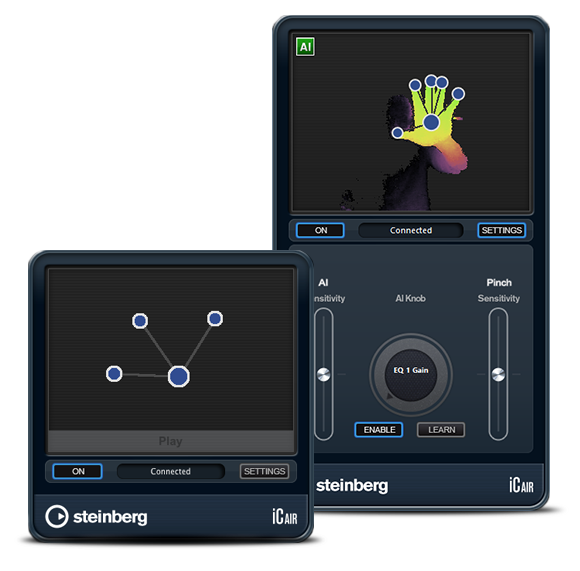
Cubase iC Air, erm… artists’ rendering. Just about got that mix right. (Hold on – red ball. This track is not going to be premeditated.)
When it comes to big, flagship audio tools, you don’t get a whole lot of sci-fi in your software. That makes Steinberg’s announcements this week more of a change of pace. They aren’t the first to talk about virtual studio sessions, or even gesturally-controlled music. But seeing this as an add-on to Cubase, not just an experimental hack, counts as news.
And Cubase users can add on those futuristic capabilities in the form of two new tools.
You can fly through Cubase sessions with gestural controls using depth cameras (on Windows) or LEAP Motion (on Windows and Mac). And you can cross time and space by connecting remotely to Cubase projects – soon, even through your mobile device.
Cubase iC Air: Gestural Control
iC Air is a new add-on, available free, that lets Cubase 7 users (in any edition) control various parameters without touching a controller, simply by using hand gestures in front of a camera or sensor.
Right now, the most likely way to do that will be via the LEAP Motion hardware, because it’s readily available and compatible with both OS X and Windows. But the Steinberg engineers also support a set of developer tools from Intel called the Intel Perceptual Computing SDK 2013. That promises support with future depth cameras, including, at the moment, one made by Creative Labs. That’s mostly future-proofing, though, as you need to actually fill out a developer form to even get hold of the one camera that currently works. (More on why that’s interesting in a moment.)
Regardless of input hardware, you get the same basic capabilities. People aren’t doing the “devil horns” sign in the video just for dramatic flair; that’s actually a discrete gesture.
The Minority Report comparison here is apt, as this is the mode of interaction depicted in the movie: particular hand positions and gestures like zooming work much as the now-aging sci fi film predicted. (That’s because interaction experts consulted on the movie.)
Specific positions of your hand will control starting and stopping the transport. (Three spread fingers start, five – think Stop in the Name of Love – bring things to a halt.)
Make circular motions, and you “spin” the transport position in forward or rewind. Swipe horizontally or vertically to switch between tracks. Move your hand left and right with a gesture to control the shuttle.
Most impressively, spreading your fingers apart or bringing them close together controls zoom.
And the combination of zoom and transport means this could be genuinely useful when recording while, say, holding a guitar.
Sadly, giving your computer the middle finger (or two fingers, British folk) will not trigger undo/delete. Yet.
Of course, it’d be a missed opportunity if you couldn’t control other parameters, as well. Using Cubase’s “AI Knob,” you can assign gestures to free control of any parameters, for Theremin-style manipulation of things like effects levels. (It also disables the other gestures, so you don’t get overly confused.) On the LEAP, you hold your palm parallel to your desk and hold your hand above the LEAP sensor. When using a camera with the Intel tools, your palm faces your computer screen and moves up and down in the camera range. (It looks, therefore, like the LEAP has a slight edge, at least for now – but perhaps soon PC depth cameras will become more commonplace.)
Other than that, if you’ve got a licensed copy of Cubase 7, you can give this a go. We’ll be doing that soon in the studio with our LEAP.
CUBASE IC AIR [Downloads, documentation and info]
Now, as for the Intel dev tools, for now, you’re probably out of luck – even if you’re a developer. Developer kits are out of stock, and there’s no sign yet of the commercial Creative product, dubbed the Creative Senze3D, that I could find.
But Intel’s long-range plans for “conceptual computing” look fascinating. They include the sort of thing you’ve seen on Microsoft’s Kinect, but aimed at general PC audiences. (Microsoft promises some of that, too, but we won’t see general-purpose PC SDKs until next year, as far as the new Kinect camera. It’ll be interesting to see who delivers first, and most widely.)
And Intel, who years before the Kinect popularized computer vision with their OpenCV toolkit, have a lot of ideas in mind. They list speech recognition, individual finger tracking in 3D, facial analysis, augmented reality, and 3D point clouds in their sights.
See the SDK page for more info.
And if you do have Cubase and LEAP, let us know how this goes. Especially if you can do a good Tom Cruise impersonation.
